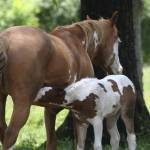Drinking and Eating Behavior in Foals

Foals drink milk, right? Yes, but have you ever given much thought as to how much milk they drink? Or when they start drinking water? Not surprisingly, the drinking and eating behavior of foals is not much different than their mature relatives.
In general, mare’s milk provides all the nutritional needs of foals in the first six to eight weeks of life. By seven days old, foals drink 25% of their body weight in milk each day.
Though milk is unquestionably the mainstay of a young foal’s diet, the transition to traditional feeds may be swift. Foals frequently swipe concentrate from their dams’ feed buckets, or gum hay in the first few days of life, some as young as a day old. Most have taken a real interest in the dam’s feed by one week of age. The amount of concentrate eaten at that time does not contribute significantly to their nutrient intake. The ability to process forages—especially hay—comes as more teeth erupt. Once that happens, they can chew more significant amounts of feed and forage.
One-week-old foals spend less than 10% of their day eating solid food, but by 21 weeks of age, they spend approximately 50% of the day eating feed or forage. Foals maintained in stalls with their dams learn to eat solid food faster than those kept solely on pasture. Feral foals were seen spending 18-24% of their day grazing at two to four weeks, 42-45% at 20-28 weeks, and 73% at 5 months of age.
Milk and Water Consumption of Foals
Some foals are sipping curiously at water on the first day of life, but for most it takes a few days before the physiologic trigger to drink kicks in and the unusual sensation of their whiskers touching the water is dulled. In general, foals learn from watching their dams and other adults, but instinctive behavior encourages drinking as well. It is this drinking instinct that makes teaching orphan foals to drink from buckets a relatively easy task.
Foals drink water less frequently than adults, and their drinking bouts are shorter. The duration has been measured at around a half a minute in foals, while an adult can drink as long as one minute.
One-month-old foals drink about 17.5 kg (39 lb) milk per day and about 4 kg (9 lb) water per day, while two-month-old foals drink about the same amount of milk but more water, about 5.5 kg (12 lb) per day.
Water intake in foals increases with age, but milk intake does not. This may be because they are eating more solid food, which is causing an increase in thirst response.
Other Considerations for Water Intake
Here are several additional thoughts when considering water intake for young and mature horses:
▪ Horses drink more water when it is available to them at all times than when restricted to a couple of drinking opportunities per day.
▪ Outside temperature will influence water intake; intake may decrease 6-14% with there is a significant drop in temperature. Conversely, the higher the temperature, the more water the horse will consume.
▪ Diet influences water intake. When horses are consuming pasture grasses (which usually contain 70-80% water), the desire to drink water and the total quantity will be much less than when eating dried forages like hay.
▪ Temperature of the water influences intake. Intake can decrease by as much as 40% when the outside temperature is below freezing and the water temperature is low. Keeping the temperature of the water over 60o F (16o C) improves intake in cold weather.
▪ Salt and water consumption have a linear relationship. The more salt a horse eats, the more water it will drink.
▪ The amount of “total dissolved solids” (TDS) in the water will influence intake. As TDS increase, intake decreases. This may not be an issue unless the only water available is from a pond, which can be much higher in TDS than tap water, decreasing desirability by the animal.








